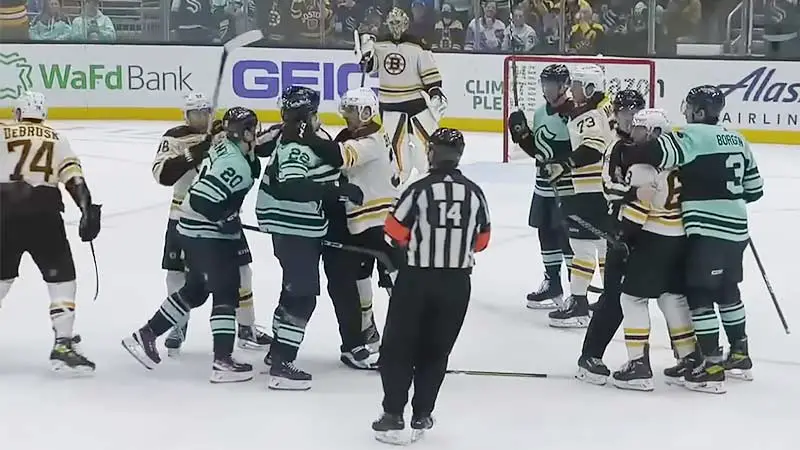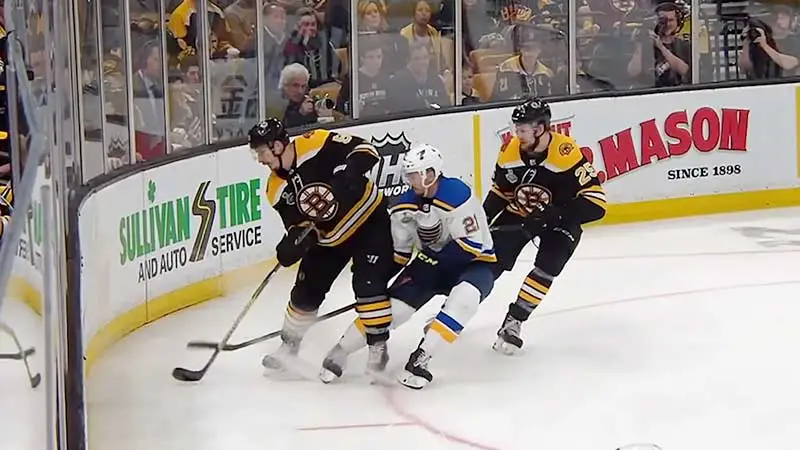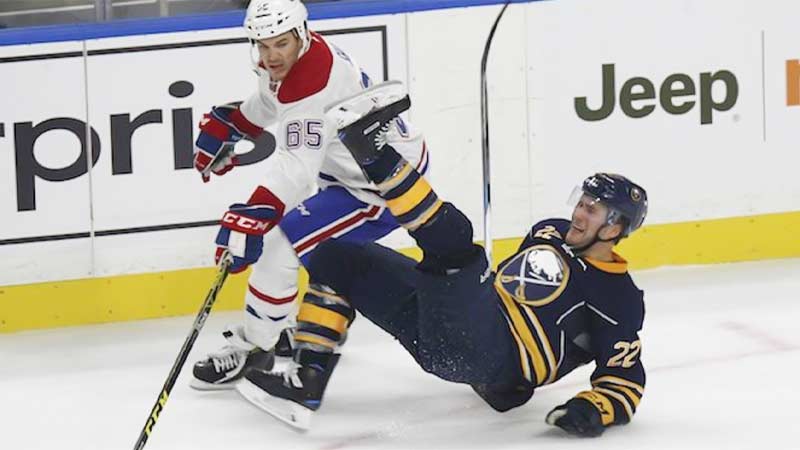In the fast-paced world of hockey, a term lingers on the ice that strikes fear into players and officials alike – slew footing.
This dangerous infraction involves a player using their leg or foot to trip an opponent from behind, often resulting in a catastrophic fall. From youth leagues to the professional NHL, education and vigilance are crucial in preventing such reckless plays.
Slew footing not only jeopardizes player safety but also shifts the dynamics of a game in a flash. The consequences are severe, with penalties ranging from major penalties to game misconducts.
The NHL and other hockey organizations are staunch in their efforts to eliminate this dirty tactic from the sport, emphasizing the importance of fair play and player welfare above all else.
Understanding Slew Foot in Hockey
The Definition and Mechanics of Slew Footing
Slew footing in hockey refers to a deliberate act by a player to off-balance an opponent by sweeping or kicking their feet from beneath them.
This dangerous tactic involves using the leg or foot to destabilize an opposing player, causing them to fall unexpectedly and risking potential injury.
The NHL defines slew footing as targeting an opponent’s lower body with the intent to cause a sudden fall, which violates the core principles of fair play and sportsmanship in the game.
Key Characteristics and Examples
Key characteristics of slew footing include the intentional nature of the action and the specific targeting of an opponent’s lower body to disrupt their balance.
Players who engage in slew footing risk severe penalties, including game misconducts, major penalties, or suspensions, depending on the severity of the infraction.
Notable examples of slew footing incidents involve prominent players like Brad Marchand of the Boston Bruins and PK Subban, who faced disciplinary actions for violating this rule.
The NHL and hockey organizations emphasize the importance of eliminating slew footing to ensure player safety and uphold the integrity of the sport.
The Rules and Regulations

NHL Rulebook on Slew Footing
In the NHL, slew footing is defined as the intentional act of using a leg or foot to knock an opponent’s feet out from under them, causing a sudden and violent fall.
This dangerous tactic targets the lower body of an opponent and is strictly prohibited due to its high risk of injury.
The NHL Rulebook explicitly states that any player engaging in slew footing will face severe penalties to uphold fair play principles and ensure player safety on the ice.
The Severity Spectrum: Minor to Major Penalties
When it comes to penalties for slew footing in hockey, the severity ranges from minor infractions to major consequences.
Minor penalties may be assessed for less severe instances of slew footing, resulting in the player spending a short time in the penalty box.
On the other hand, major penalties are handed out for egregious acts of slew footing that pose a significant risk to the safety of the targeted player.
In more severe cases, players may also receive game misconduct penalties or even suspensions, emphasizing the zero-tolerance approach towards this dangerous tactic in professional hockey.
The Role of Officials in Managing Slew Foot Incidents
Signage and Signals for Slew Footing
Hockey officials are vital in addressing slew foot incidents by closely monitoring foul play on the ice.
Clear signals and signage are utilized to effectively communicate penalties for such infractions, ensuring that all involved parties comprehend the offense and its repercussions.
This transparent approach reinforces fair play and emphasizes the seriousness of dangerous actions like slew footing.
Enforcement of Penalties by Referees
Enforcing penalties for slew footing falls under the jurisdiction of referees during a hockey game. It is vital for officials to act decisively and impartially when penalizing players for engaging in this dangerous tactic.
Referees must assess the severity of the infraction and apply the appropriate penalty according to the NHL Rulebook.
Referees have the authority to issue penalties such as minor infractions, major penalties, game misconducts, or even suspensions based on the intentional nature and impact of the slew foot incident.
By enforcing penalties consistently and fairly, officials uphold the sportsmanship of the game and deter players from endangering their opponents through reckless actions like slew footing.
The Impact on Player Safety

Short-Term and Long-Term Injuries from Slew Footing
Players engaging in slew footing risk causing both short-term and long-term injuries to their opponents.
This dangerous tactic, where a player trips another from behind, can lead to immediate injuries such as sprains, fractures, or concussions.
Additionally, the repetitive nature of these incidents can result in long-term musculoskeletal issues or chronic conditions for the victim.
The NHL’s strict penalties for slew footing underscore the league’s commitment to preventing such actions that jeopardize player safety on the ice.
Player Safety Initiatives Against Slew Footing
To combat the prevalence of slew footing in hockey, player safety initiatives have been implemented to educate athletes on the risks and consequences associated with this forbidden maneuver.
By enhancing awareness through training programs and emphasizing the severe penalties imposed for such actions, leagues strive to create a safer environment for players.
Additionally, enhanced monitoring by referees and the NHL Department of Player Safety serves as a deterrent, ensuring that players understand the zero-tolerance policy towards any behavior that compromises player safety.
High-Profile Case Studies
The NHL has taken significant disciplinary actions in response to slew footing incidents, involving players like Brad Marchand and PK Subban.
Marchand’s aggressive play led to a suspension after he slew footed an opponent during a game against the Pittsburgh Penguins.
Similarly, Subban faced severe penalties for his slew foot on a rival player in a critical playoff match, highlighting the league’s commitment to fair play and player safety by swiftly addressing such dangerous tactics.
Prevention and Education Strategies
The Importance of Coaching on Avoiding Slew Foot
Coaches are instrumental in educating players about the dangers of slew footing in hockey, emphasizing fair play, respect for opponents, and adherence to rules.
Through training sessions and drills, coaches teach proper techniques and sportsmanship to foster a culture of safety within the team.
By encouraging open communication and setting clear expectations around sportsmanship, coaches serve as mentors who shape players’ holistic understanding of the game and promote a positive team culture that values fair competition and mutual respect, ultimately reducing slew footing incidents during matches.
How the League is Addressing Player Education?
Professional hockey leagues, including the NHL, are implementing comprehensive measures to educate players about serious infractions such as slew footing. This approach is designed to promote a culture of safety, respect, and accountability within the sport.
Comprehensive Training Programs
The league provides extensive training programs for players to learn about on-ice rules and behavior, focusing on player safety, fair play, and ethics.
Interactive sessions and hands-on training help players understand the risks of dangerous actions such as slew footing.
Workshops and Seminars
The league arranges workshops and seminars featuring guest speakers such as former players, coaches, and officials to address player safety and responsible play.
Through interactive discussions and real-life examples, these sessions emphasize fair play standards and help players grasp the impact of their actions on the game and opponents.
Direct Communication with Players
League officials focus on clear and effective communication to highlight player safety and ethical conduct to players, coaches, and team personnel.
They employ methods such as meetings, presentations, memos, and newsletters to guarantee that key messages are effectively communicated and individual concerns are addressed, ensuring that crucial information is disseminated throughout the league.
Emphasis on Consequences
The league focuses on highlighting the severe consequences of acts like slew footing to protect player safety.
Players are educated about potential fines, suspensions, and damage to their reputation. By emphasizing the personal and professional repercussions, the league aims to deter risky behaviors and encourage players to prioritize the safety of their peers.
Continuous Evaluation and Improvement
The league continuously evaluates and improves player education programs by gathering feedback from players, coaches, and stakeholders.
This process allows the league to adapt its educational strategies to address evolving needs, ensuring a proactive approach in promoting player safety and ethical conduct.
Frequently Asked Questions
What is the importance of preventing slew footing in hockey?
Preventing slew footing is crucial in maintaining fair play and player safety in hockey. Slew footing can cause serious injuries to players and disrupt the integrity of the game. Coaches play a vital role in educating players about the dangers of slew footing and promoting sportsmanship on the ice.
How do professional hockey leagues tackle the issue of slew footing?
Professional hockey leagues, like the NHL, actively engage in player education programs to prevent intentional infractions like slew footing.
They emphasize accountability, safety, and fair play through training initiatives and stringent enforcement of rules. By combining education with strict penalties, leagues aim to uphold the integrity of the game and prioritize player well-being.
Conclusion
Slew footing in hockey is a dangerous tactic that can have serious consequences for players on the ice.
By enforcing strict penalties and focusing on education and prevention strategies, leagues like the NHL are working to promote fair play and player safety.
Coaches play a crucial role in educating players about the risks associated with slew footing and emphasizing the importance of playing the game with integrity.
Through training programs and a culture of accountability, professional hockey leagues are striving to eliminate intentional infractions like slew footing.
By combining educational initiatives with rigorous enforcement of rules, the league aims to uphold fair play standards and ensure the integrity of the game.








James Felix